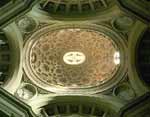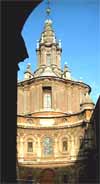 Francesco Castelli, better known as Borromini, was born in Bissone, by the lake of Lugano in 1599.
Francesco Castelli, better known as Borromini, was born in Bissone, by the lake of Lugano in 1599.
He was very young when he moved to Milan to study "the art of building". In Rome he worked with Carlo Maderno and Gianlorenzo Bernini on Palazzo Barberini. He is the author of some of the work on the back façade and on the elliptical stair. He helped Bernini with the Canopy of St Peter after Maderno died. Almost immediately the two artists fell out and Borromini moved on to work on his own on the project for the church and the cloister of St Carlo alle Quattro Fontane, known as St Carlino.
The cloister has a rectangular planwith two columns in each rounded corner, turning the rectangle into an octagon with curved sides.
This motive (alternation between convex and concave shapes which gives the impression ofexpanding and contracting surfaces) is also found in the church, which has an elliptical plan with recesses and jutting parts. The dome is decorated with crosses, hexagons and octagons, arranged in a complex design.
 The artist also carried out renovation work on Palazzo Spada and Palazzo Falconieri.
The artist also carried out renovation work on Palazzo Spada and Palazzo Falconieri.
In 1637 he started building the Oratory and Convent of the Philippine Fathers and finished it in 1649. There are convex and concave surfaces in thisbuilding as well, projecting the interior’s dynamic tension onto the exterior of the building.
Between 1642 and 1660 Borromini worked on the church of Sant'Ivo alla Sapienza. The interior of the church has a central plan with two intersecting equilateral triangles; three apses and three niches alternate, creating a plan which had never been used before. The same balance can be appreciated in the church’s exterior, in the tiburium covering the dome and in the lantern.
In 1646 Pope Innocent X Pamphili employed the artist to transform the church of St John in the Lateran. Borromini managed to satisfy the need to preserve the ancient basilica yet solve the static problems which had arisen. He added a pair of columns in large pilasters.
In 1657 Innocent X decided to terminate his appointment. The two men probably had had serious disagreements following the construction of the church of Sant'Agnese in piazza Navona. The following years were very difficult for Borromini and the crisis ended only with the building of the Collegio di Propaganda Fide.
Borromini committed suicide by throwing himself onto a sword in Rome in 1660.